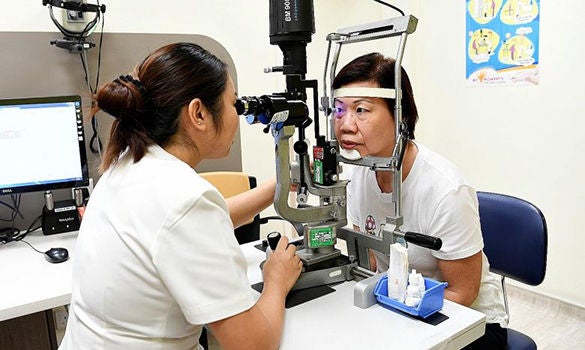
checking a patient's eye pressure at the SNEC clinic. The virtual clinic has cut down waiting time for low-risk patients by calling them with test results and scheduling appointments. ST PHOTO: KHALID BABA
Senior staff nurse Joanne Ng checking a patient's eye pressure at the SNEC clinic. The virtual clinic has cut down waiting time for low-risk patients by calling them with test results and scheduling appointments. ST PHOTO: KHALID BABA
Patients with no glaucoma or has a mild case to get results at home, instead of seeing doctor.
A new system at the Singapore National Eye Centre (SNEC) has cut the average time low-risk patients spend in the clinic - from more than two hours to just one hour. Those who test negative for glaucoma or who have stable glaucoma can get the results at home, instead of seeing a doctor to get the results.
Nurses at the Glaucoma Observation Clinic call patients about their test results and schedule future appointments - more than halving the amount of time they spend there.
The clinic has managed 158 patients since it opened in July.
The new system has freed up doctors to tend to higher-risk glaucoma cases at SNEC, which manages about 20,000 glaucoma patients every year, said Dr Annabel Chew, a consultant at the centre's Glaucoma Department.
Unlike other countries such as the United Kingdom, Singapore does not have glaucoma screening in the primary care setting of general practitioners and polyclinics, so it is handled in tertiary institutions like SNEC, said Dr Chew.
There are long waiting times for patients and sometimes it is difficult for them to get earlier appointments, she added.
"The doctors have a finite amount of time and we have limited resources in the clinic, so we should see patients who have more complex glaucoma and who need active management,'' she said.
An SNEC study showed that in 2016, up to 40 per cent of cases managed by its glaucoma clinics were low-risk cases, or patients who were at risk of developing glaucoma.
The clinic is a boon for patients like Madam Lim Ing Hua, 61, who was screened and found not to have glaucoma.
"I didn't have to wait that long and left the clinic in an hour. Overall, the service was better," said Madam Lim, a housewife.
After her visit, a nurse rang her within a few days to tell her the results and schedule a screening appointment.
From next year, the results will be mailed to patients instead.
There will be more frequent follow-up appointments for those with more severe or unstable glaucoma. Those who develop a new, urgent condition like a sudden loss of vision will be directed to SNEC's walk-in clinic, said Dr Chew.
To accommodate more patients, SNEC is doubling the number of weekly sessions at the Glaucoma Observation Clinic to two next year. Each session can take in 14 patients.
SNEC will also roll out the new system to its branch clinics at Bedok, Changi General Hospital and Sengkang General Hospital within the next two or three years, said Associate Professor Tina Wong, head of the centre's Glaucoma Department.
She added that the centre hopes to manage 1,500 glaucoma patients every year at the virtual clinics by 2022.
Author: Felicia Choo
Source: The Straits Times, Singapore Press Holdings Limited. Reproduced with permission.
Contributed by














 Get it on Google Play
Get it on Google Play